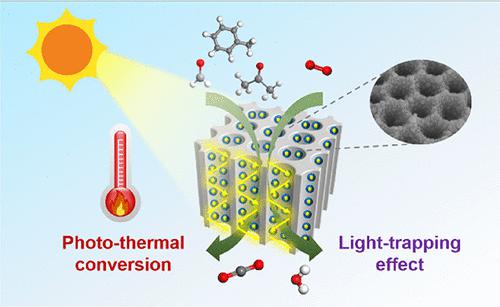当前位置:
X-MOL 学术
›
Environ. Sci. Technol.
›
论文详情
Our official English website, www.x-mol.net, welcomes your feedback! (Note: you will need to create a separate account there.)
Efficient Photothermal Catalytic Oxidation Enabled by Three-Dimensional Nanochannel Substrates
Environmental Science & Technology ( IF 11.4 ) Pub Date : 2024-03-08 , DOI: 10.1021/acs.est.3c09077 Yifei Li, Qianpeng Zhang, Yanan Chong, Wei-Hsiang Huang, Chi-Liang Chen, Xiaojing Jin, Guangxu Chen, Zhiyong Fan, Yongcai Qiu, Daiqi Ye
Environmental Science & Technology ( IF 11.4 ) Pub Date : 2024-03-08 , DOI: 10.1021/acs.est.3c09077 Yifei Li, Qianpeng Zhang, Yanan Chong, Wei-Hsiang Huang, Chi-Liang Chen, Xiaojing Jin, Guangxu Chen, Zhiyong Fan, Yongcai Qiu, Daiqi Ye

|
Photothermal catalysis exhibits promising prospects to overcome the shortcomings of high-energy consumption of traditional thermal catalysis and the low efficiency of photocatalysis. However, there is still a challenge to develop catalysts with outstanding light absorption capability and photothermal conversion efficiency for the degradation of atmospheric pollutants. Herein, we introduced the Co3O4 layer and Pt nanoclusters into the three-dimensional (3D) porous membrane through the atomic layer deposition (ALD) technique, leading to a Pt/Co3O4/AAO monolithic catalyst. The 3D ordered nanochannel structure can significantly enhance the solar absorption capacity through the light-trapping effect. Therefore, the embedded Pt/Co3O4 catalyst can be rapidly heated and the O2 adsorbed on the Pt clusters can be activated to generate sufficient O2– species, exhibiting outstanding activity for the diverse VOCs (toluene, acetone, and formaldehyde) degradation. Optical characterization and simulation calculation confirmed that Pt/Co3O4/AAO exhibited state-of-the-art light absorption and a notable localized surface plasmon resonance (LSPR) effect. In situ diffuse reflectance infrared Fourier transform spectrometry (in situ DRIFTS) studies demonstrated that light irradiation can accelerate the conversion of intermediates during toluene and acetone oxidation, thereby inhibiting byproduct accumulation. Our finding extends the application of AAO’s optical properties in photothermal catalytic degradation of air pollutants.
中文翻译:

三维纳米通道基底实现高效光热催化氧化
光热催化克服了传统热催化能耗高、光催化效率低的缺点,具有广阔的应用前景。然而,开发具有出色的光吸收能力和光热转换效率的催化剂来降解大气污染物仍然是一个挑战。在此,我们通过原子层沉积(ALD)技术将Co 3 O 4层和Pt纳米团簇引入三维(3D)多孔膜中,形成Pt/Co 3 O 4 /AAO整体式催化剂。 3D有序纳米通道结构可以通过光捕获效应显着增强太阳能吸收能力。因此,嵌入的Pt/Co 3 O 4催化剂可以快速加热,并且可以激活吸附在Pt簇上的O 2 ,产生足够的O 2 -物种,对多种VOC(甲苯、丙酮和甲醛)表现出出色的活性降解。光学表征和模拟计算证实Pt/Co 3 O 4 /AAO表现出最先进的光吸收和显着的局域表面等离子体共振(LSPR)效应。原位漫反射红外傅里叶变换光谱(in situ DRIFTS)研究表明,光照射可以加速甲苯和丙酮氧化过程中中间体的转化,从而抑制副产物的积累。我们的发现扩展了 AAO 光学特性在光热催化降解空气污染物中的应用。
更新日期:2024-03-08
中文翻译:

三维纳米通道基底实现高效光热催化氧化
光热催化克服了传统热催化能耗高、光催化效率低的缺点,具有广阔的应用前景。然而,开发具有出色的光吸收能力和光热转换效率的催化剂来降解大气污染物仍然是一个挑战。在此,我们通过原子层沉积(ALD)技术将Co 3 O 4层和Pt纳米团簇引入三维(3D)多孔膜中,形成Pt/Co 3 O 4 /AAO整体式催化剂。 3D有序纳米通道结构可以通过光捕获效应显着增强太阳能吸收能力。因此,嵌入的Pt/Co 3 O 4催化剂可以快速加热,并且可以激活吸附在Pt簇上的O 2 ,产生足够的O 2 -物种,对多种VOC(甲苯、丙酮和甲醛)表现出出色的活性降解。光学表征和模拟计算证实Pt/Co 3 O 4 /AAO表现出最先进的光吸收和显着的局域表面等离子体共振(LSPR)效应。原位漫反射红外傅里叶变换光谱(in situ DRIFTS)研究表明,光照射可以加速甲苯和丙酮氧化过程中中间体的转化,从而抑制副产物的积累。我们的发现扩展了 AAO 光学特性在光热催化降解空气污染物中的应用。



























 京公网安备 11010802027423号
京公网安备 11010802027423号